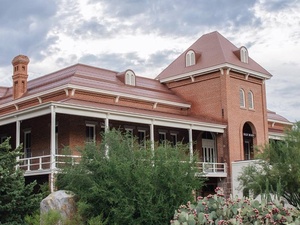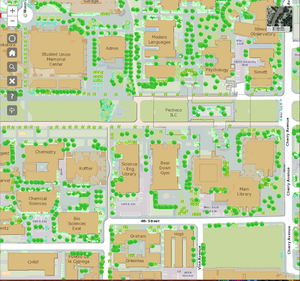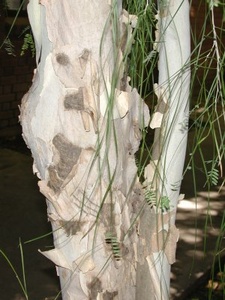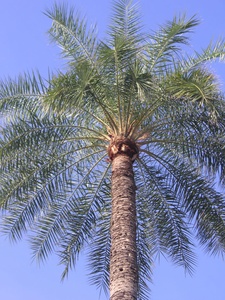About the Arboretum
The University of Arizona Arboretum has nearly 9,000 woody plans and cactus on record, representing about 550 species from six continents.A lot of trees there have very long history, when the university is in its early age, it have a very important purpose is to help the economic growth at the place. so a lot of the co-workers try to bring plants and sell them for money as agriculture products, this will also make the economic grow a little bit at that time. Nowadays, because the area of U of A is becoming larger and larger, the arboretum is almost become a part of the university , it contains nearly 9000 woody plans on record, that is a really huge number. The university of Arizona Campus Arboretum is a living laboratory promoting stewardship and conservation of urban trees through research ,education and outreach.
Open all day
Free to visit
Can schedule tour with U of A arboretum on https://arboretum.arizona.edu/, it offer several different kind of tours in the university.
location of the arboretum
The UA Campus Arboretum comprises all space on which the University has developed facilities: the Main Campus from Euclid to Campbell Avenue and from Sixth Street north, across Speedway, to the space surrounding the University Medical Center. All plantings adjoining UA buildings or defining University open space, in Pima County, Arizona, may be considered as a part of the University of Arizona Arboretum.The UA Campus Arboretum covers nearly 400 acres.
University of Arizona Campus Arboretum
4-H PROGRAMS
Tucson, AZ 85719
History of the arboretum
The University of Arizona main campus houses is a truly unique collection of plants from arid and semi-arid climates around the world. These trees represent the University'shistorical dedication to sustainable desert horticulture and tell the story of the cultural evolution of the modern southwest. In the beginning, olive trees and date palms were trialed as potential cash crops and cacti were collected to encourage appreciation and learning about the native desert. By mid-century, growing urbanization and heightened awareness of natural resources, encouraged faculty like Dr. Warren Jones to shift the focus to improving landscape ornamentals. The University of Arizona campus is now the home of hundreds of native and arid-adapted trees and shrub species from every continent on earth. Many campus trees are the largest specimens in Arizona and have been designated as Great Trees of Arizona. Five of these Great Trees have been on the National Register of Big Trees. The Heritage Trees are stately reflections of the University's rich history. Several trees are unique to the Southwest; a few were the first of their kind to be planted in the Western Hemisphere.
In September, 2002, the UA Campus Arboretum was officially dedicated and accepted as a member of the American Public Garden Association with the charge to preserve and enhance this significant collection and to promote stewardship and conservation of urban trees. In 2005, the Taylor Family Botanical Plaza was formally dedicated in front of the newly refurbished Herring Hall and in 2010 the University of Arizona Campus Arboretum was designated a Tree campus USA by the National Arbor Day Foundation and Toyota. For a broader description of the goals of the UA Campus Arboretum, please see the Concept Statement.
Purpose for the Arboretum
1. Help the economic growth
2. U of A is a land grant school, so it has a responsibility to provide science-based knowledge that addresses the state's needs, such as the increasing demand for water use and environmental impact in the state's urbanized centers.
3.Education tool, student and professor can use plants in Arboretum to do research.
4. provides opportunities to model practices that could later guide other urban areas.
5.The University of Arizona Campus Arboretum was established to preserve, curate and enhance this extensive collection as a resource for research and educational programs that promote the historic, scientific, environmental, economic, aesthetic, and educational value of trees in urban deserts.
Tour to the Arboretum
People can follow the tour guides under the Find Trees and tours on( https://arboretum.arizona.edu/tree_tours) to find the tours they want, there is a Tour and event Calendar on the top of the page, and there is a schedule of time when people can have a tour to U of a Campus Arboretum. There are several different types of tours Arboretum offered,such as arboretum history tour, trees around the world tour ,edible landscapes tour, medical plants tour, mediterranean tour , tropical trip tour and sonoran native plants tour. Every different kind of tour provide different knowledge about plants and there's average one tour a week. Also ,visitors can choose to have self-guided tour, Self-guided tour booklets can be printed from the links below or checked out from 101 Herring Hall on weekdays before 4pm.
Special Collections
1. Blooming plants
The University of Arizona Campus Arboretum boasts trees and unique plants from arid climates around the world. Seasonal cues such as soil temperature, rainfall, or the presence of pollinators will induce flowering. At any time of year, there might be lusty tropical clusters, aromatic scents from desert species, golden pannicles of pollen, red hot floret spikes, or white night-blooming bat-luring blossoms.
2.U of A Heritage Trees
Many of the unique trees on the University of Arizona campus are the oldest or most stately trees on campus, or are in some way connected with former faculty or University of Arizona heritage. Some were the first to be planted in Tucson or in the territory of Arizona. Others were collected through international travels by UA botanists. A few are the only specimens in Tucson. The Heritage trees represent a very important link to the University of Arizona's status as the only Land Grant institute in the Sonoran Desert.
3.Arizona Great Trees
The University of Arizona's trees are among the oldest in the state, or are, in other ways, unique. Since 2001, the Campus Arboretum has been successful in nominating and receiving recognition for the following trees on our campus as Great Trees of Arizona by the Arizona Department of State Lands. All of these trees are also UA Heritage Trees. For more information on the Great Trees of Arizona program go to the Arizona Community Tree Council's GreatTrees website
Plants in the Arboretum
The University of Arizona Arboretum has nearly 9,000 woody plans and cactus on record, representing about 550 species from six continents. Such as The boojum, UA Palms , UA olives and a lot of different kind of cactus.
Contact
The University of Arizona Campus Arboretum
P.O. Box 210036
Tucson AZ, 85721
Telephone: 520-621-7074
Email: [email protected]
More information about University of Arizona Campus Arboretum please visit https://arboretum.arizona.edu to get more information.
Resources
https://arboretum.arizona.edu/mission
https://www.azpm.org/s/17670-ua-campus-has-collection-of-woody-plants-for-education-research/













